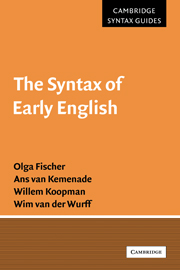Book contents
- Frontmatter
- Contents
- Preface
- List of editions used
- 1 Language change and grammar change
- 2 An outline of Old English syntax
- 3 An outline of Middle English syntax
- 4 The Verb-Second constraint and its loss
- 5 The loss of object–verb word order
- 6 Verb–particles in Old and Middle English
- 7 Changes in infinitival constructions
- 8 The history of the ‘easy-to-please’ construction
- 9 Grammaticalization and grammar change
- References
- Index
3 - An outline of Middle English syntax
Published online by Cambridge University Press: 23 December 2009
- Frontmatter
- Contents
- Preface
- List of editions used
- 1 Language change and grammar change
- 2 An outline of Old English syntax
- 3 An outline of Middle English syntax
- 4 The Verb-Second constraint and its loss
- 5 The loss of object–verb word order
- 6 Verb–particles in Old and Middle English
- 7 Changes in infinitival constructions
- 8 The history of the ‘easy-to-please’ construction
- 9 Grammaticalization and grammar change
- References
- Index
Summary
Introductory remarks
This chapter presents a broad outline of the syntax of Middle English, i.e. English in the period 1100–1500. Many of the syntactic phenomena found in Old English, as described in chapter 2, continue in this period, but there is also a great deal of change. In fact, it has often been said that, while Old English is to all intents and purposes a foreign language to present-day speakers of English, (late) Middle English writings, such as those of Chaucer, Gower and Malory, do not confront modern readers with any major syntactic obstacles to comprehension. As the editors of a widely used anthology of Middle English literature put it: ‘There are many subtle differences in syntax between Middle English and Modern English, but few will present any difficulty to the reader’ (Dunn and Byrnes 1973: 13). The main reason for this difference is no doubt the occurrence of change in many areas of grammar between the Old and Middle English periods.
In chapters 4 to 9, we shall trace some of the individual changes in detail. It is with the aim of providing a framework against which to interpret these changes that this chapter sketches the basics of Middle English syntax, corresponding to the sketch of Old English in chapter 2. In section 3.2 we consider inflections in Middle English, and look at two constructions (impersonals and passives) characterized by special inflectional marking of grammatical roles. Section 3.3 deals with word order, both within the NP and within the clause.
As the descriptions in the following sections and chapters will make clear, Middle English syntax is characterized by greater variability than Old English syntax.
- Type
- Chapter
- Information
- The Syntax of Early English , pp. 68 - 103Publisher: Cambridge University PressPrint publication year: 2001
- 1
- Cited by

